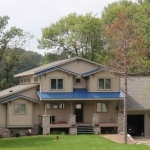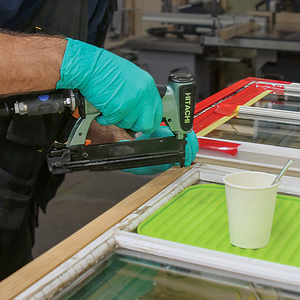I just realized that the12″ sonotubes (already poured) are spaced 9’6″ apart. (looked good on paper. . . ) There are 5 of them.
The double 2×10 or 2×12 beam that sits on the 4×4’s is where I think I will have the problem. In order to have the seams land on the 4×4’s, I’ll need to start with green treated lumber at 20′ long. I should be able to S.O. that, no? I’m used to only seeing green treated up to 16′ long.
The 4×4’s that sit on the piers will only be about 2′ high.
Side question, should one choose to carriage-bolt the beam to the posts, how do you handle seams in the beam? A scarf joint with holes through both does not seem right to me. Do you use 6×4 or 6×6 min posts so there is enough room for 4 bolts (2 per beam either side of the seam)?
I think I prefer the through bolting or lapping the beams on the posts. Those “stack on top” simpson brackets don’t seem to provide much racking resistance, but at this point they seem like my only choice.
Edit: Menards: 2×12 x 20’L 30.99 each Now back to your regularly scheduled posting – – –
Maybe I should just delete? Naw, I am still interested in the pier to beam questions. . . .
Edited 4/29/2007 7:25 pm by jhausch




















Replies
A few ways I like to handle the post to beam connection:
Notch both sides of a 6x6 to accept (2) 2x12's, carriage bolted through the post.
Bolt 2x12's to both sides of a 4x4 (if the height of the 4x4 won't be too much) and add bolsters (2x4's that are 18" to 24" long) below the 2x12's.
Use Simpson hardware to make the connection easy.
Side note: Make sure you land the joints on the posts. An engineer could tell you where to place joints mid-span that would actually improve performance, but it takes some work to figure out and rules of thumb like 1/4 the span are not accurate.
I think the 6x6 would give me enough real-estate for a seam on a post with room for 4 bolts. I've thought about bolsters, but still need more room for the seam. . .
Interesting comment about "engineered joints mid-span", but I probably won't take the time to research that one. I would not try on my own.
I use 6x6 and cut a 3" notch. I like nailing my beam, 2 - 2x10's, together. The notch in the 6x6 is 9" high and 3" deep. I secure the beam to the 6x6 with 2 - 5/8" carriage bolts (code here, Pittsburgh).
I would never split my beam in between posts.
When the beam is split over a 6x6, I need a total of 4 - 5/8" carriage bolts.
I also place Grace's DekProtector membrane over the beam and it also covers the beam to post connection.
Dave Otto -- Otto Construction -- PA
Good comment on the grace.
Looking more and more like I'll need to get some 6x6's.
I don't understand why you can't use 10-foot members.
A technique I've used is to notch the end of the 4x4 and set in a length of 5/4 decking, oriented vertically, then rest the beam members on either side of that. Has a nice appearance for a visible joint. The beam members won't bear totally on the 4x4 (would have plenty of bearing on 6x) but bear enough that you have a joint you can be confident in.
But in this case, since the joint will be concealed, I'd just scab (with bolts) a piece of 5/4 or some such to the side (or both sides) of the 4x4. In addition, you could use a piece of 1/2" foundation ply between the members as a spacer and as splice block at the joints. To be really belt-and-suspenders, stop the scabbed pieces about 4-5 inches from the top and attach a horizontal piece of 5/4 across the joint.
Re: 10' members. Trying to minimize all those joints.
Interesting idea to use more lumber to provide the room for the bolts. Do you mean like I've shown in the attachment?
That's the basic idea. Can also use the same technique to attach beam to posts.
So convenient a thing it is to be a reasonable Creature, since it enables one to find or make a Reason for everything one has a mind to do. --Benjamin Franklin
good point, if I make that "joining plate" so it extends down to the 4x4, that would really make for a nice joint. Maybe even have some fun with the shape. . . .
I'll need to pick up some 1/2" treated ply, but I think you've been a big help on this onw.
Thanks!
Another point: If you do get 20-footers you can lap the boards by 10 feet. This eliminates any fear of a joint pulling apart.
So convenient a thing it is to be a reasonable Creature, since it enables one to find or make a Reason for everything one has a mind to do. --Benjamin Franklin
If it was me I would use 1/4 points if your allowed. To me will help with rolling at the joints. Just one opinion.
Edited 4/29/2007 11:16 pm ET by silvertip
WHat are 1/4 Points?
One problem you'll have with 20-foot pieces is transporting them.
So you've seen me pulling my tiny trailer with my Honda Element, then?
I would recommend stainless connectors for the ACQ
http://www.strongtie.com/ftp/fliers/F-SS06.pdf
Check at a real lumber yard for the PT 20 footers.
Regarding the 4x4 post to beam connection, assuming you are going to use 4x4 posts, the beam should sit on top of the 4x4s. Then scab a 2x4 on the back of the post and beam to tie the 2 together. You may need to scab small pieces of PT 1/2" plywood on the back of the beam to make everything line up.
One of the very basic concepts for frame carpentry is that gravity should be used whenever possible to hold up a structure. Hence the beam sits on top of the support column. The fasteners just help the members stay in place. Attaching a beam to the side of a post, for example, is going against that principle and you are putting the fasteners in shear. Granted carriage bolting as you suggested will work fine, but you just added ~$40 of expense to your project for marginal gains if any.
BTW - our code requires 5/8 HD gal bolts, nuts, and washers for any structural deck connections. Lag bolts are not permitted for anything but railing to deck connections, which even that I try to avoid. Have no idea of what your code requires.
As suggested above using 6x6 posts would resolve all your post to beam connection problems, and in that case, since the fasteners aren't in shear, you could actually use whatever size of fastener you wanted - within reason. The 6x6 posts would only add a minimal cost to the deck construction.
Edited 4/30/2007 8:28 am ET by Matt
I'm with you on the gravity concept, but we all know that there's no such thing as gravity. The earth sucks.
Seriously, though, my concern in the stacking arrangement is the "hinge" points. However, scabbing on 2x4 lengths on the back-side would fix that. I think I'll go that way.
Placing your joints away from the supports is a stronger solution if done correctly. With a continuous span that is uniformly loaded, the largest negative moment (tension at the top of the beam) is over the support and the largest positive moment (tension bottom of beam) is closer to center span. Somewhere in the middle (theoretically) there is zero bending moment. Reality dicates non-uniform loading, so this zero moment point moves around. However, the single member present in that zone is adequate. The most important part is to provide adequate joining of the multiple members to transfer shear between them. I would tend toward a shallower triple member than a double 2x12. Also, 4x4 posts on decks may be adequate, but always look too spindly even when just stubs.
" Somewhere in the middle (theoretically) there is zero bending moment."
I think you're thinking of a zero SHEAR point. there is no point where bending is zero.
Even if there was, it would only apply is the load was perfectly uniform. That never happens.
I never bought into the idea that splicing off a support was stronger. I think splicing over them is better.
But I also know that point is hotly debated.
I really wish I was less of a thinking man, and more a fool who's not afraid of rejection. [Billy Joel]
Yup, zero moment with uniform loading occurs in predictable locations. Zero shear corresponds to the maximum bending moment. Unloading one span completely would result in a zone of positive moment, however the magnitude would be approximately half the design negative moment. Therefore if you always had at least one continuous member it would take really bad carpentry to cause a problem. Around here the decks would typically see there larges service load when snow drifts in off the roof. Splicing at the supports is a good safe solution to those who don't do structural engineering every day. Choosing a differetn support point can render a slightly stiffer system, just like running joists continuous over a support versus a simple span. You can weel imagine my own deck having these details fine tuned, as well as the proportion of the cantilever joists to the backspan. This is the stuff that keeps me going.
When I rebuilt my deck 18 mo. ago (11+ by42 ft), I used a triple 2x10. Existing piers were 10 ft & few inches apart. For inner and outer 2x10s I spliced over the posts. For the central 2x10 I did it in with three 14 footers, so the joints in that were at 4+ ft in toward the center from the second and 4th posts. Comments?
That works. Interestingly, while it seems contrary to standard practice, a stiffer system would have resulted if the inner and outer plys were swapped.
Here is what I did. I'll post a pic when I get the carriage bolts in the "scabs". Their just tacked in place now.
View Image